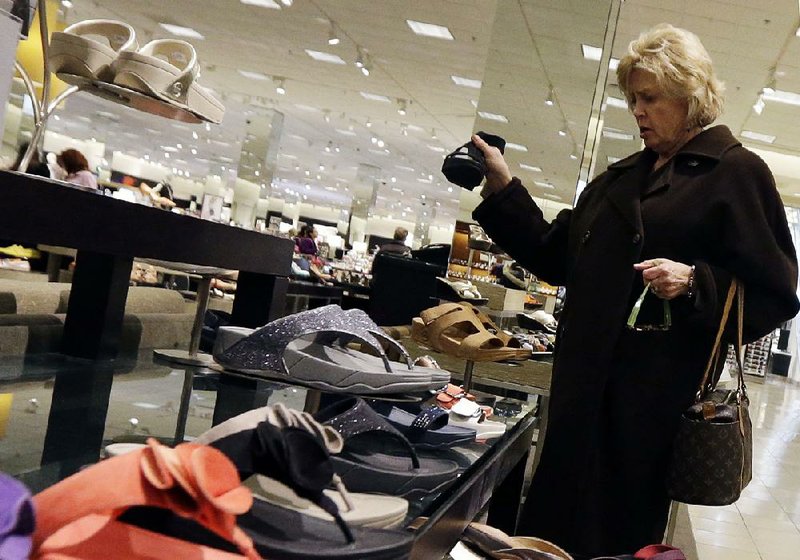WASHINGTON - Americans kept increasing their spending in March and their income grew, the Commerce Department reported Monday.
Consumer spending rose 0.2 percent in March from February. That followed a 0.7 percent jump in February and a 0.3 percent gain in January.
Income increased 0.2 percent last month after a gain of 1.1 percent in February. After-tax income also rose 0.2 percent.
The “surprisingly strong consumer spending is not going to continue,” Michael Carey, chief economist for North America at Credit Agricole CIB in New York, said before the report. “Things will be slower this quarter. We’re going to need more broad-based increases in employment and income.”
Higher income has helped offset an increase in Social Security taxes that took effect Jan. 1. On Friday, the government said consumer spending rose from January through March at the fastest pace in more than two years.
“The consumer is doing reasonably well,” Joseph LaVorgna, an economist at Deutsche Bank, said in a note to clients.
U.S. stocks rose Monday with the Standard & Poor’s 500 Index advancing to a record high. The S&P 500 rose 0.7 percent to 1,593.61 and the Dow Jones industrial average rose 106.20 points, or 0.7 percent, to 14,818.75.
Spending on services drove the March increase. That was partly because it was an unseasonably cold month, which required Americans to pay more to heat their homes.
Higher spending on utilities does not signal consumer confidence the way purchases on household goods, such as new appliances or furniture, typically do. And other reports suggest consumers may be starting to feel the effect of the tax increase, the result of Congress deciding last year not to extend a two-year temporary tax break. Sales at retail stores and restaurants fell in March by the most in nine months.
The 2 percentage-point tax increase has reduced tax-home pay for nearly all Americans. A person earning $50,000 a year will have about $1,000 less to spend this year. A household with two highly paid workers will have up to $4,500 less.
That may slow consumer spending and economic growth in the April-June quarter. Consumer spending accounts for about 70 percent of economic activity.
“Consumers are struggling to cope with slow income growth and higher taxes this year even as inflation pressures have eased,” said senior economist Eugenio Aleman of Wells Fargo in a note to clients.
Other trends may offset some of the impact of the taxes this year. Consumers have cut their debts and rising home values and stock prices have increased household wealth.
In addition, gasoline has become cheaper. The national average price for a gallon of gas has fallen by 29 cents since Feb. 27 to $3.50. A decline in gas prices leaves consumers with more money to spend on other things.In Arkansas on Monday the average price of a gallon of gasoline was $3.25, down from $3.29 a week ago, according to auto club AAA.
Consumer spending was actually stronger in March after adjusting for the drop in gasoline prices. Inflation-adjusted spending rose at a slightly faster 0.3 percent pace. That matched February’s inflation-adjusted rate and was higher than January’s.
Steady hiring has helped consumers maintain spending, though job gains slowed in March. Employers added just 88,000 jobs last month, much lower than the average of 220,000 per month in the preceding four months.
Economists forecast that the slowdown was temporary. They predict job gains in April rebounded to 160,000, although the unemployment rate is expected to remain at 7.6 percent. The Labor Department will issue the April employment report Friday.
On Friday, the Commerce Department said the economy expanded 2.5 percent at an annual rate in the January-March quarter. That was much better than the 0.4 percent growth recorded in the fourth quarter. Growth was buoyed by the large increase in consumer spending.
In a healthy economy, with an unemployment rate between 5 percent and 6 percent, GDP growth of 2.5 percent or 3 percent would be considered solid. But the U.S. hasn’t been able to maintain that pace since the recession ended nearly four years ago. And in today’s still-struggling recovery, with unemployment at 7.6 percent, the economy needs faster growth to generate enough jobs to quickly shrink unemployment.
Since the recession officially ended in June 2009, growth has remained weaker than usual after a severe downturn. The economy expanded just 2.4 percent in 2010, 1.8 percent in 2011 and 2.2 percent in 2012.
Information for this article was contributed by Christopher S. Rugaber of The Associated Press, Shobhana Chandra of Bloomberg News and Jeffry Bartash of MarketWatch.
Front Section, Pages 1 on 04/30/2013

